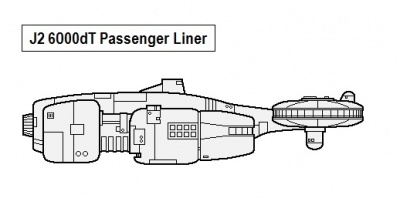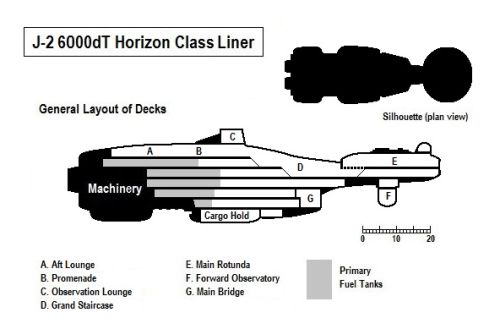Horizon class Passenger Liner
| Horizon class Passenger Liner | |
|---|---|
 | |
| Type: M Liner | |
| Category | BCS |
| Size | 6,000 Tons |
| Hull Configuration | Cone Hull |
| Streamlining | Streamlined Hull |
| Tech Level | TL–11 |
| Engineering | |
| Computer | Model/4 |
| Jump | J-2 |
| Maneuver | 3 G |
| Armaments | |
| Hardpoints | 60 |
| Offensive | 30 triple laser turrets,30 triple Sandcaster turrets |
| Accommodations | |
| Staterooms | 600 |
| Low Berths | 200 |
| Personnel | |
| Crew | 101 |
| Officers | 21 |
| Enlisted | 80 |
| High/Mid Passengers | 400 |
| Low Passengers | 200 |
| Payload | |
| Cargo | 360 Tons |
| Fuel tank | 1,380 Tons |
| Carried craft | 5 50t Lifeboats, 2 40t boats |
| Construction | |
| Construction Time | 29 Months |
| Origin | Distant Fringe |
| Price | |
| Cost | MCr4,450.284 |
| Architect fee | MCr44.50 |
| Statistics | |
| Universal Ship Profile | M–F223341–090000–80000-0 |
| Images | |
| Blueprint | No |
| Illustration | Yes |
| Source | |
| Canon | Unpublished, fan design |
| Designer | Ade Stewart |
| Design System | High Guard |
| Era | 1105 |
| Starships are designed with the Classic Traveller format, using High Guard Shipyard v1.13 written by Andrea Vallance. | |
The Horizon class Passenger Liner is a TL–11 Passenger Liner.
- Please also see AAB article: Ships of the Distant Fringe.
Description
The Passenger Liner is a large commercial transport commonly encountered along Star Lanes within the Distant Fringe region. It is classified as a Luxury Liner and is constructed as a conventional design. Similar designs have been in use from the time the Distant Fringe was first settled.
Image Repository
- A Horizon class Passenger Liner in side view.

General Description
The Horizon class Liner is a two part hull, with the aft section consisting of a streamlined cone with a length of around 75 meters and a forward disk-shaped section with a diameter of around 35 meters. Some elements of the hull are narrower and some are wider, giving the vessel a total enclosed volume of approximately 81,000 cubic meters.
Fuel Tanks wrap around the central and rear sections of the ship. The cargo hold includes the cryogenic (low berth) section. Working sections of the vessel such as the laundry, the galleys and general crew quarters are located aft. Senior officers are accommodated forward, close to the bridge, while stewards have rooms close to passenger cabins. Middle passage accommodations are found in the less desirable midsection of the vessel while first class cabins are located in the rotunda, with windows offering spectacular views. The main commercial and leisure facilities are located in the forward core regions and are focused on the Grand Staircase and the upper rotunda.

A basic deck plan of the vessel indicating the general layout and positioning of major elements.
Basic Ship Characteristics
Following the Imperial Navy and IISS Universal Ship Profile and data, additional information is presented in the format shown here. The small craft factor indicates the number of squadrons (...of ten craft) carried on the ship. Tonnage on the universal ship profile is shown in kilotons (thousands of tons) where necessary. [1]
| No. | Category | Remarks |
|---|---|---|
| 1. | Tonnage | The Passenger Liner is constructed using a 6,000 Ton hull built in a generally conical configuration. The hull is streamlined, giving good atmospheric performance that is further enhanced by its onboard gravitic systems.
|
| 2. | Crew | Total Crew Complement: x101
Accommodations:
There are 200 Low Berths.
Accessible areas of the hull are fitted with grav plates and inertial compensators and have full life support and environmental systems.
|
| 3. | Performance | The vessel mounts a DeVoss-type Jump-2 drive, a Maneuver-3 drive, and a Power Plant-3, giving performance of Jump-2, 3-G acceleration, and producing 180 Energy Points. The ship has an agility rating of 2 and an emergency agility of 3. The internal fuel tankage is sufficient for one Jump-2 and gives the power plant 4 weeks duration.
|
| 4. | Electronics | Adjacent to the bridge is a Model/4 Computer: the vessel has a backup Model/4 Computer.
|
| 5. | Hardpoints | x60 hardpoints.
|
| 6. | Armament | The normal weapons fit-out for a Passenger Liner is:
x30 triple Beam Laser turrets, forming three batteries of 10 linked turrets |
| 7. | Defenses | The hull is unarmored.
x30 triple Sandcaster turrets, forming three batteries of 10 linked turrets The vessel is not fitted with screens or other passive defensive systems. |
| 8. | Craft | Flight Section
The subcraft are housed in dedicated hangars located at strategic points around the vessel: the hangars can be sealed and have a total volume of 429 Tons. |
| 9. | Fuel Treatment | The vessel has internal fuel tankage of 1,380 Tons.
|
| 10. | Cost | The basic cost of the vessel, including all of its subcraft, is MCr4,450.284 |
| 11. | Construction Time | 123 weeks (29 months) as standard.
|
| 12. | Comments | Standard cargo capacity amounts to 360 Tons.
|
History & Background (Dossier)
The design is representative and a large number of variants exist, particularly with regard to the allotted weapons systems, onboard electronics, and the fit out of internal spaces. Passenger Liners generally follow predetermined routes, often with extended layovers at locations to allow tourism and sightseeing. Liners of this type have been pressed into service as troop transports during conflicts.
Class Naming Practice/s & Peculiarities
A number of companies manufacture ships equivalent to the Horizon class.
They vary in hull shape and internal layout but all share the same basic design and all have very similar capabilities and performance characteristics.
Each variant class is named by the company that produces it: these organizations generally draw on traditional naming protocols. It is not uncommon for a historical class name to be reused. Individual vessels within a class are issued specific serial numbers and transponder codes but traditionally are named by their owners. This is considered a serious affair and a ship with a frivolous name is considered "unlucky".
Selected Variant Types & Classes
35 Representative Liner (M) Classes
Civilian Ship - Liner - Type M Liner
B
C
- Camel class Medical Launch
- Celestial Star class Luxury Liner
- Codori Prime class Luxury Liner
- Condor class Subsidized Liner
- Coyotl class Bulk Hauler
E
F
G
H
I
K
- K'Bam class Assault Lander
- Kihrvak Platoon Drop Ship class Marine Cutter
- King Richard class Interstellar Liner
L
M
N
O
P
R
S
- Sapphire Moon class Moduleship
- Shuvalivashtu class Luxury Liner
- Songbird class Ship's Boat
- Star class Merchant Liner
- Stellar class Liner
T
X
References
| This article has metadata. |

|
This ship was originally designed using one of the Classic Traveller ship design rules:
|
- Author: Lord (Marquis) and Master Scout Emeritus Adie Alegoric Stewart of the IISS
- ↑ Timothy B. Brown. Fighting Ships (Game Designers Workshop, 1981), 10.
- ↑ Timothy B. Brown. Fighting Ships (Game Designers Workshop, 1981), 10.